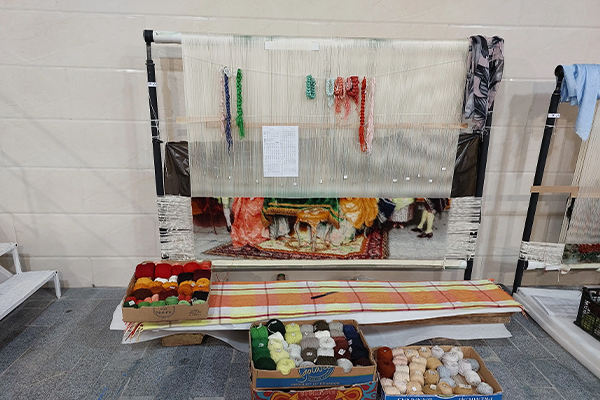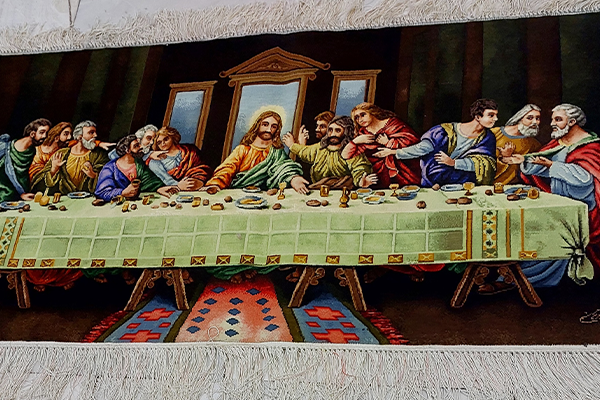Persian Tapestries: Exquisite Masterpieces of Woven Art
Persian tapestries, also known as Persian pictorial rugs, are renowned masterpieces of woven art that have captivated admirers for centuries. These exquisite creations, meticulously crafted by skilled artisans, transcend the realm of mere floor coverings, elevating themselves to the status of artistic treasures. Each tapestry narrates a story, depicting scenes from Persian mythology, literature, and history, showcasing the rich cultural heritage and artistic brilliance of the Persian people.

The origins of Persian tapestry weaving can be traced back to the ancient Achaemenid Empire (550-330 BCE), where tapestries adorned the palaces of kings and nobles. These early tapestries were characterized by bold colors, geometric patterns, and stylized depictions of animals and mythical creatures. Over time, the art of Persian tapestry weaving evolved, incorporating influences from neighboring cultures and reflecting the changing artistic sensibilities of the era.
During the Sassanian period (224-651 CE), Persian tapestry weaving reached new heights of sophistication. Tapestries from this era were renowned for their intricate designs, vibrant colors, and realistic portrayals of human figures, animals, and landscapes. These tapestries often depicted scenes from courtly life, hunting expeditions, and mythological tales, showcasing the grandeur and opulence of the Sassanian Empire.
The Islamic conquest of Persia in the 7th century CE introduced new artistic elements and motifs to Persian tapestry weaving. Islamic calligraphy, geometric patterns, and stylized floral designs became prominent features, reflecting the influence of Islamic art. Despite these changes, Persian tapestry weaving retained its unique identity, incorporating Islamic elements into its rich artistic heritage.
The Mongol invasion of Persia in the 13th century CE brought about a further transformation of Persian tapestry weaving. Chinese artistic influences became evident, with tapestries featuring stylized depictions of dragons, phoenixes, and other fantastical creatures. The Mongols also introduced new weaving techniques, such as the use of silk and metallic threads, which added richness and depth to the tapestries.
The Timurid era (14th-15th centuries CE) marked a golden age for Persian tapestry weaving. Under the patronage of Timurid rulers, tapestry workshops flourished, producing masterpieces that are still admired today. These tapestries were characterized by their intricate designs, harmonious color palettes, and realistic portrayals of human figures, animals, and landscapes. They often depicted scenes from Persian literature, such as the Shahnameh, the epic book of Persian kings, and the works of Rumi, the renowned Sufi poet.
The Safavid period (16th-18th centuries CE) saw a continued flourishing of Persian tapestry weaving. Safavid rulers, embracing their Persian heritage, actively promoted the arts, including tapestry weaving. Tapestries from this era were renowned for their large size, intricate designs, and use of luxurious materials, such as silk, gold, and silver threads. They often depicted scenes from royal ceremonies, hunting expeditions, and battles, showcasing the power and grandeur of the Safavid Empire.
In the 19th and 20th centuries, Persian tapestry weaving faced challenges due to political instability and economic changes. However, the art form did not die out. Artisans continued to produce tapestries, albeit in smaller numbers. The establishment of fine arts schools and museums helped to preserve the tradition and revive interest in Persian tapestry weaving.
Types of Persian Tapestries
Garden alley tapestry

Mother's seal tapestry

Last Dinner tapestry

Peacock tapestry

Today, Persian tapestries are recognized as masterpieces of art and cultural heritage. They are prized by collectors worldwide for their exquisite beauty, intricate craftsmanship, and historical significance. These tapestries serve as a testament to the enduring artistry and rich cultural heritage of Persia, continuing to captivate and inspire generations of art lovers.
Key Characteristics of Persian Tapestries:
- Intricate Designs: Persian tapestries are renowned for their intricate designs, often featuring a multitude of details and patterns.
- Vibrant Colors: Persian tapestries are characterized by their use of vibrant colors, often incorporating gold and silver threads.
- Realistic Portrayals: Persian tapestries are known for their realistic portrayals of human figures, animals, and landscapes.
- Rich Cultural Heritage: Persian tapestries reflect the rich cultural heritage of Persia, depicting scenes from mythology, literature, and history.
- Exquisite Craftsmanship: Persian tapestries are meticulously crafted by skilled artisans, using traditional weaving techniques passed down through generations.
- Persian Tapestries: A Legacy of Artistic Brilliance
Persian tapestries stand as enduring testaments to the artistic brilliance and cultural heritage of Persia. These exquisite masterpieces, woven with passion and skill, continue to captivate and inspire art lovers worldwide, preserving a legacy that spans centuries. Each tapestry narrates a story, transporting viewers to a realm of beauty, craftsmanship, and cultural richness. Owning a Persian tapestry is not merely acquiring a piece of art; it is embracing a legacy of artistry, cultural heritage, and timeless beauty.


